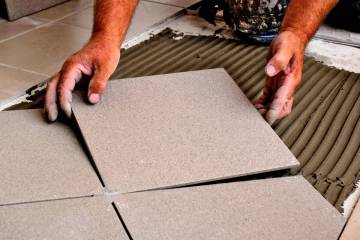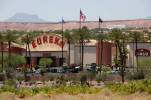EDDHA iron works miracles in garden
Q: Thank you very much for letting us know about EDDHA iron. It’s a miracle fertilizer for gardeners in the Mojave Desert. This kumquat had been in the pot for at least four years and, in spite of all my efforts, was pitiful with yellow leaves and stunted growth. Two applications of EDDHA a couple of weeks apart in late February and look at it now.
A: Thanks for the kudos on EDDHA iron chelate applications. It can be a miracle iron application with yellowing citrus when all your other efforts fail. Other iron applications, such as Kerex, will work in most circumstances and is less expensive to buy. To save money some iron fertilizers contain a very tiny amount of EDDHA iron chelate.
The reason I recommend iron EDDHA is because it works under all circumstances and is 100 percent EDDHA iron, not a tiny amount. It has to do with soil chemistry. It works when applied to the soil:
Early in the growing season along with your first fertilizer application.
When soil alkalinity (pH) is above 7.6.
This time of year (late May), soil applications of iron products are not the best because the plant isn’t producing much new growth. The new growth is nearly finished for many plants. In order for soil applications of iron to work, there has to be new growth.
May, June or July are the times of the year when foliar or leaf sprays are applied to correct the yellowing of leaves due to an iron problem. As temperatures rise, new growth is slowing down.
Foliar sprays (spraying the leaves with a liquid solution of iron) are substituted for soil applications. Plants prefer the iron available to them in the spring so apply iron to the soil, rather than spraying it.
The same situation with alkalinity (soil pH) applies to the water used for spraying. Our tap water has alkalinity that is too high. It must be lowered.
This is done by adding either a cup of vinegar (acid) to the spray solution or using distilled water which naturally has lower alkalinity. So either throw a cup of vinegar into a bucket of water or use distilled water for spraying iron on the yellow leaves to correct this yellowing. After you do this, any foliar-applied iron product should work as long as it dissolves in the water.
Add a teaspoon of liquid soap detergent to the spray mix after you finished. The liquid soap substitutes for plant roots and moves the iron inside the leaves easier.
Q: I have two large pots with hollyhocks in them. They were planted last fall. They got larger through the winter months and began blooming this spring. Now they are drying up. Should I pull them up or just cut them back? If I cut them back, should I continue to water them during the hot days of summer? Can I put vinca in the pot with them to get color throughout the summer?
A: Hollyhocks do very well in our Las Vegas climate in full sun and open air but not close to west-facing or south-facing hot walls. So does vinca. Vinca likes the heat. Ideally, hollyhocks are best shaded from the afternoon sun but get at least eight hours of sunlight each day. Never plant hollyhocks in the shade.
Some people plant hollyhocks as winter biennials in our climate; they plant them in the fall by seed or young transplants and pull or replace them as they turn brown after flowering. You can either cut them back close to the soil surface and let them re-sucker and flower again or you can replace them. But they must be watered and kept alive for that to happen.
Hollyhocks commonly reseed themselves after they finish flowering. If you are watering the area, you will see small seedlings growing in the soil after the hollyhocks have finished flowering and dropped their seeds.
You can grow them up into mature plants if you want to or you can weed them out. A weed is a plant out of place. Either move the hollyhocks to a preferred location when they are 3 inches tall or appreciate the native wild look or remove them as weeds. Your preference.
Hollyhocks, because their height ranges from 3 to 6 feet tall and are multicolored, make a great background plant or something you can plant further back in your landscape. You can use other flowering perennials in front of them like the shorter varieties of vinca for instance.
In your case, vinca would make a great understory plant for the hollyhocks when they start blooming again. By the way, vinca can be taken indoors, and they will flower through most of the winter.
As far as growing hollyhocks in containers, I have never done that. I have only grown them in the ground.
When growing them in containers, make sure you irrigate before the heat of the day and keep the soil moist. Moist, but not constantly wet. The use of woodchips as a mulch on the surface of the soil helps keep the soil cooler, releases nutrients and microorganisms as they rot, and helps keep the soil moist.
Q: I saw your Fuyu persimmon tree orchard video and was wondering which rootstock was used and why is this rootstock the best for the Las Vegas area? I have a small yard and don’t want a 30-foot tree. How do I know if the tree will fruit? Are they easy to grow here? Should I shade the young tree? What about temperatures over 100 degrees?
A: Asian or Japanese persimmon will grow in our climate in full sun. They don’t like it, but they will grow. I would suggest growing them on the east side of a building like your home, so they get shade from the afternoon sun.
Because they are Japanese or Asian, they prefer a soil amended with compost and covered with a wood chip mulch that easily decomposes. They will not do well in soil covered by a rock mulch.
Japanese persimmon is commercially grown on its own roots. That’s how I got them. I understand that some of the Japanese persimmons now are available grafted on our native persimmon.
Native persimmon is found growing in the eastern woodlands of Kentucky and Tennessee. I have no experience with native persimmon rootstock, but I would guess they would tolerate our climate well.
It’s best to grow persimmon surrounded by other trees so they get some shade and protection from our hot sun. They perform the worst if planted on the south or west side of a building with lots of reflected heat and surrounded by rock mulch.
I have been able to grow 10 varieties of persimmon with only the variety Hachiya not setting fruit, which I think is a humidity problem. All the Fuyu types of persimmons, the flat fruit, are doing well. Varieties that I have grown successfully include Fuyu, Chocolate, Coffeecake and Giant Fuyu. Watch my videos.
I select persimmon that has limbs coming from the trunk up to knee height and lower. I don’t like persimmon trees with limbs much higher than knee height because of harvesting at lower heights.
I grow Japanese persimmon 10 feet apart and do not let them grow above 10 feet in height. I winter-prune them at 7 to 7½ feet tall. I reprune the tips on persimmon after new growth is a few inches long.
Q: You recently mentioned fireblight disease on fruit and other trees in the valley. I noticed black discoloration on my bay laurel bush and would like your input as to whether this is fireblight or something else that has taken over the new growth. Any suggestions you have would be greatly appreciated.
A: This is not fireblight disease even though there is some black discoloration. It might be confused with sooty canker disease. I see sooty canker disease frequently on mulberries and ash trees weakened by a lack of water. Sooty canker disease is a very weak disease.
Fireblight disease is a highly contagious bacterial disease that affects plants almost always in the rose family. Bay or sweet laurel is in the laurel family.
Fireblight is most destructive to Asian pear, many European pears including ornamental pear, some apples, pyracantha, cotoneaster and other plants in the rose family. The disease causes the blackening of leaves and new stems in dying plants.
Just like sooty canker disease, it can be spread from plant to plant by pruning. The black discoloration is the reason it’s called fireblight.
Bob Morris is a horticulture expert and professor emeritus of the University of Nevada, Las Vegas. Visit his blog at xtremehorticulture.blogspot.com. Send questions to Extremehort@aol.com.





























